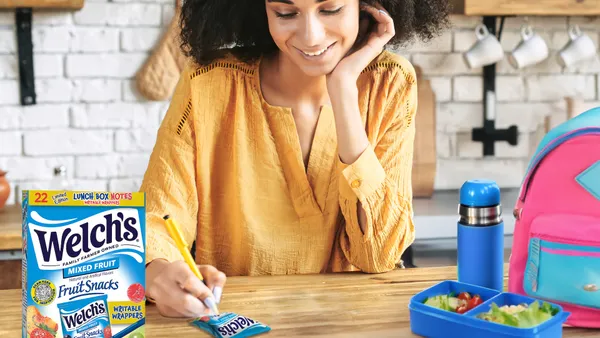Dive Brief:
- M&M's is updating its branding to put a larger emphasis on inclusivity and belonging, according to a press release. The effort was done in partnership with creative agency BBDO New York, design shop Jones Knowles Ritchie and public relations firm Weber Shandwick, per details emailed to Marketing Dive.
- The Mars Wrigley line's ampersand will be used more prominently, doubling as a point of connection between the two Ms and a symbol of how the brand can unite people. M&M's mascots are getting a modernized look as well, with makeovers drawing out their "nuanced personalities" in a celebration of self-expression. M&M's color palette and a mix of candies in different shapes and sizes will receive greater attention to demonstrate how society is more fun together, per the announcement.
- Marketing will focus more on unifying messages while preserving M&M's established sense of humor. The company is backing up the overhaul with a commitment to increase a sense of belonging for 10 million people globally by 2025. The initiative will be tracked in part through a new M&M's Fund encompassing financial support, mentorship and resources in the arts and entertainment industry.
Dive Insight:
M&M's is recentering its purpose around inclusivity with a brand overhaul. The strategy is wide-ranging, touching across advertising, retail stores, brand activations and the personas and appearance of M&M's longstanding candy mascots. Changes to packaging and character designs are subtle but symbolic — the female green M&M has swapped out high-heeled boots in favor of sneakers, for instance — while M&M's is upholding its "jester wit and humor" even as a theme of unity is foregrounded.
The idea is to position fun as a powerful means of connecting people and instilling a sense of belonging. It's a simple concept that could resonate during a period marked by intense division. U.S. consumers are the most likely to say society is conflicted along partisan, racial and ethnic lines, according to a recent Pew Research Center survey of divisiveness in advanced nations. At the same time, even addressing topics like inclusivity in marketing can be a touchy subject matter for consumers who prefer to keep brands and politics separate.
M&M's might sidestep such skepticism by throwing a spotlight on messages that are simple and light-hearted. That's a tack that lost some standing in the solemn early days of the pandemic but has seen a resurgence as marketers try to provide a reprieve to COVID-19 stressors. Fifty-seven percent of consumers surveyed by research platform Attest said they want to see more humor from brands this year.
Narrowing in on inclusivity could also be a bid by M&M's to connect with young cohorts like Gen Z that place a premium on progressive social values. Nearly half (46%) of Gen Zers want to see brands tackle prickly topics like racism, Attest found, versus 30% of baby boomers who said the same.
Adding a real-world impact to the refresh, M&M's is striving to help 10 million people feel more included over the next three years. The pledge is low on details but squares with other projects from M&M's parent company. Mars has committed to better balancing gender in leadership teams and annual diversity audits of its advertising independently conducted by the Geena Davis Institute. The firm also serves as vice-chair of the Unstereotype Alliance, a role it first took on last April.
Only a few weeks in, 2022 has already brought several ambitious brand overhauls. Brewing giant Anheuser-Busch earlier this week updated its visual identity and logo to shore up a premium, forward-looking approach, with a more striking use of gold hues that recall the color of beer and barley. Coca-Cola continues to introduce new packaging that carries a bolder logo and attempts to better differentiate between beverage variants.















